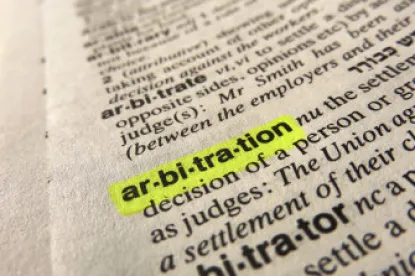Arbitration provides a lower-cost alternative to litigation. Yet, a growing predicament continues to penetrate the conversation surrounding arbitration: mass arbitration. On the one hand, no rational customer or employee would spend the funds required to arbitrate claims that are worth less than the total costs. On the other hand, when parties file such claims individually en masse, companies may be on the hook to pay millions in filing fees. As a result, the company could pay up to 10 times the claimant’s potential recovery. In order to address this growing concern, parties are beginning to evaluate the benefits and burdens of their arbitration agreements.
The benefits of arbitration agreements are generally well known. For example, unlike the random assignment of a judge, arbitration agreements give the parties the flexibility to agree mutually on a decision-maker or set guidelines for a prospective arbitrator’s qualifications or experience, which can avoid the unpredictability of potential jury verdicts. Further, arbitration agreements can provide the parties with a higher level of privacy than is available in court. Unlike most court documents, arbitration hearings and decisions are typically private due to confidentiality agreements.[1] As such, arbitration allows employers to maintain privacy regarding employment matters that may otherwise reveal confidential business information.
In addition to these general benefits, the U.S. Supreme Court recently held in Epic Systems Corp. v. Lewis[2] that arbitration allows employers to avoid costly collective actions. In deciding the validity of an arbitration agreement that limited employees from taking collective action, the Supreme Court held that such agreements “must be enforced as written.”[3] Given this, employers have used similar agreements to avoid the notice requirement to all potentially affected individuals, thereby reducing the number of claims filed and costs expended on a particular issue.[4]
While arbitration is often also beneficial to employees due to the time and cost savings, an employee may face a scenario where the cost of bringing a claim outweighs the potential benefit. For employees with small claims, the potential benefit of pursuing individual arbitration in a claim worth only hundreds of dollars is little to none. As one attorney stated in federal court, no rational customer would arbitrate a US$162 claim against a company given the costs related to arbitration.[5]
Recently, where arbitration agreements restrict the filing of class actions, counsel for employees have opted to file thousands of individual arbitration claims within a short timeframe, thereby triggering the requirement that the employer pay the filing fee for each claim––approximately US$1,500.[6] In some cases, this mass filing of arbitration claims can commit an employer to paying more than US$12 million in filing fees alone.[7] This allows employees with the lowest-value claims to artificially inflate their claim value by imposing filing fees on employers that are potentially multiple times higher than the claim’s worth.
For example, a transportation company recently sought to avoid the costs associated with a collective action on behalf of thousands of its employees. In the end, the U.S. Court of Appeals for the Ninth Circuit held that the arbitration clause was enforceable against the employees and that the employer must follow the arbitration agreement and pay the filing fee for all claims.[8] This result would have forced the employer to incur fees related to thousands of individual arbitration claims, all due within the span of a few months.[9] However, rather than individually arbitrating each claim and incurring the associated fees, the employer opted to settle all claims for US$146 million or approximately US$11,000 per claim.[10]
According to a study of one bank’s arbitration program completed by the Economic Policy Institute, individual arbitration results in the average employee-claimant paying the bank US$11,000.[11] As such, the employees’ incentive to attempt to gain an advantage on a group-wide scale should not be underestimated. Where the average claimant can end up owing US$11,000 in some contexts, it is no surprise that employees and employees’ counsel are looking for ways to harness the negotiating power of mass arbitration.
Other companies in the transportation and food industries have also faced similar debilitating fees because of mass arbitration.[12] Some employers have challenged this strategy only to be met by courts enforcing the agreements as written and requiring full arbitration of each individual claim.[13] For instance, a company in the food industry faced 2,814 claims regarding labor standards, with each individual claim valued “in the hundreds of dollars,” and the company’s challenge to the employees’ counsel was characterized by the U.S. District Court for the District of Colorado as “unseemly.”[14] However, although the court’s approach has solidified costly results for agreements that do not contain specific procedures, these decisions should alert the parties to the potential solution: using the arbitration agreement itself. Therefore, employers should carefully consider their response to mass arbitration before seeking to challenge an arbitration agreement in court, as the benefit of such deference to the written agreement can be used to alleviate mass arbitration’s burden.
Some private associations, such as the American Arbitration Association and Judicial Arbitration and Mediation Services (JAMS), have similarly maintained the enforcement of the parties’ agreements regarding filing fees depending on the nature of the arbitration agreement, even where the filing fees are financially onerous.[15] For example, when faced with a request to stay all relevant arbitration pending a decision related to mass arbitration, JAMS stated that “[w]hile it is not our preference to force the parties to litigate these issues seriatim, our policies and procedures, absent party agreement otherwise, require that we collect a filing fee in each case to be pursued.”[16] As JAMS notes, although current arbitration agreements are enforced as written, that does not preclude the parties from forming agreements to address mass arbitration.
The International Institute for Conflict Prevention and Resolution (the CPR) took this approach a step further by creating its own distinct mass arbitration procedure. On November 6, 2019, the CPR announced the launch of its new “Mass Claims Protocol and Procedure” (the Protocol).[17] Claims filed under the CPR Administered Arbitration Rules or CPR Non-Administered Arbitration Rules trigger the Protocol “any time greater than 30 individual employment-related arbitration claims of a nearly identical nature are, or have been, filed with CPR against the same Respondent(s) in close proximity to one another.”[18] The Protocol uses examples that have worked in other collective action areas, such as the early implementation of “test” cases, which function much like “bellwether” cases in class actions.[19]
The Protocol not only alleviates the time and expense of collective actions, it also provides more flexibility to the parties regarding the claims chosen as “test” cases. While the first 10 test cases are chosen via random assignment, both parties may present five additional cases for arbitration, along with reasoning “why the addition of such claims would be necessary to the mediation process.”[20] Further, the Protocol allows employers to negotiate the filing fees, providing an opportunity to avoid potentially burdensome mass arbitration expenses.[21]
As such, the Protocol may provide parties with a resource for tackling the difficulties present with mass arbitration, and it can be an informative resource to consider. Whether a company decides to adopt the Protocol or adjust fee-sharing provisions in arbitration clauses,[22] it is clear that the arbitration agreement itself can be used to create a solution. As the Protocol shows, looking to class-action procedure is a useful first step for creative changes to standard arbitration agreements. While the enforcement of arbitration agreements as written has placed an enormous burden on companies in the context of mass arbitration, the impact of such rulings on the ability to use creative solutions for this issue should not be underestimated.
NOTES
[1] Laura A Kaster, Confidentiality in U.S. Arbitration, 5 N.Y. DISP. RES. LAW. 23, 23 (Spring 2012), https://www.mediate.com/mediator/attachments/26226/Confidentiality%20in%20Arbitration%20DRSNewsSpr12.pdf.
[2] 138 S. Ct. 1612 (2018).
[3] Id. at 1632.
[4] David S. Baffa, John L. Collins & Gerald L. Maatman, Guidance for Employers Considering Mandatory Arbitration Agreements with Class and Collective Action Waivers, SEYFARTH SHAW LLP, at 4 (Dec. 2013), https://www.seyfarth.com/images/content/7/5/v1/7580/GuidanceMandatoryArbitration.pdf.
[5] Alison Frankel, Company’s Lawyers Reveal ‘Ugly Truth’ About Arbitration, Judge Threatens Contempt, REUTERS (June 1, 2018).
[6] See, e.g., Int’l Inst. for Conflict Prevention & Resolution, Pricing and Fees, https://www.cpradr.org/dispute-resolution-services/pricing-fees.
[7] Alison Frankel, ‘This Hypocrisy will not be Blessed’: Judge Orders Company to Arbitrate 5,000 Couriers’ Claims, REUTERS (Feb. 11, 2020).
[8] See 904 F.3d 1087 (9th Cir. 2018).
[9] Andrew Wallender, Company Settles ‘Majority’ of Arbitrations for at least $146M (1), BLOOMBERG L. (May 9, 2019).
[10] Id.
[11] Econ. Policy Inst., The Average Consumer in Arbitration with Bank is Ordered to Pay the Bank Nearly $11,000 (Oct. 3, 2017).
[12] Andrew Wallender, Corporate Arbitration Tactics Backfires as Claims Flood In, Daily Labor Report, BLOOMBERG L. (Feb. 11, 2019), https://news.bloomberglaw.com/daily-labor-report/corporate-arbitration-tactic-backfires-as-claims-flood-in.
[13] Civ. A. No. 1:40-cv-02612-JLK (D. Colo. Nov. 20, 2018).
[14] Id.
[15] Frankel, supra note 10.
[16] Alison Frankel, JAMS to Company: Our Rules and Your Contracts Demand Individual Arbitrations, REUTERS (Jan. 25, 2019).
[17] Int’l Inst. for Conflict Prevention & Resolution, CPR Launches New Mass Claims Protocol and Procedure, (Nov. 6, 2019), https://www.cpradr.org/news-publications/press-releases/2019-11-06-cpr-launches-new-mass-claims-protocol-and-procedure; Susan Antilla, Arbitration Storm at Company, THE AM. PROSPECT (Feb. 27, 2020).
[18] Int’l Inst. for Conflict Prevention & Resolution, Employment-related Mass Claims Protocol, at 2 (Nov. 4, 2019), https://www.cpradr.org/dispute-resolution-services/employment-related-mass-claims-documents/emp-mass-claims-protocol.
[19] Id.
[20] Id. at 3.
[21] Int’l Inst. for Conflict Prevention & Resolution, Pricing and Fees, https://www.cpradr.org/dispute-resolution-services/pricing-fees.
[22] Note that some jurisdictions have invalidated fee-sharing provisions where the provision would deter a “substantial number of potential litigants from seeking to vindicate their statutory rights.” Morrison v. Circuit City Stores, Inc., 317 F.3d 646, 663 (6th Cir. 2003); see also Nesbitt v. FCNH, Inc., 811 F.3d 371, 378 (10th Cir. 2016) (invalidating a fee-splitting arbitration provision that required plaintiff to pay US$2,500 because it “deterred vindication of federal statutory rights”).





 />i
/>i

